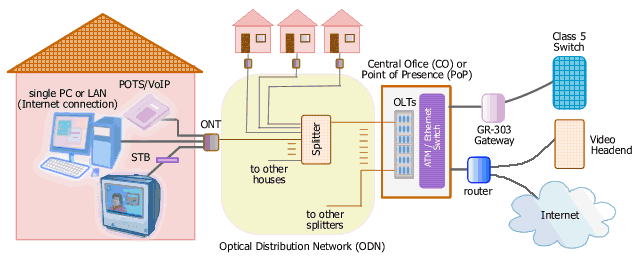Internet Access Guide : Fiber-To-The-Home (FTTH)

Picture: FTTH
A fiber optic access network delivers multiple types of services to subscribers' homes.
Fiber optic cable has long been used in backbone network, that's
the network that interconnects telephone switches and data
centers. Fiber optic cable is selected due to the advantages it has over
other transmission media.
It carries information as optical pulses (not electrical signals
as in twisted pair or coax), therefore it is immune to
interference (EMI and RFI), crosstalk, and noise. It can deliver
information over longer distance than copper or coax. It has
abundant
bandwidth for carrying information, limited only by the
equipment that lights the fiber.
FTTH or FTTP (Fiber To The Premises) brings the fiber optic cable
deeper toward customer premises if compared with FTTN (Fiber To The
Node) or FTTC (Fiber To The Curb) that is commonly used for delivering
ADSL/VDSL or cable TV. Due to the price decrease of fiber optic cable and
equipment (among other reasons), in recent years more telcos and independent service
providers have started the deployment of FTTH networks, targeting those
people not satisfied with DSL/cable Internet experience. With
competitive pricing and SLA (Service Level Agreement), most heavy
Internet users would love to switch to FTTH.
An
FTTH operator or
internet provider delivers multiple type of
services from the Central Office (CO) or Point of Presence (PoP)
via a fiber optic strand to a subscriber home. The types of
service that can be offered via FTTH network include VoIP,
lifeline POTS,
RF video, MPEG video, IPTV, HDTV, video-on-demand, pay-per-view, high speed Internet, and numerous other
services. Generally speaking, FTTH is the medium of choice for
delivering triple play services (voice, video, and data).
The CO or PoP is fed with content from Video Headend and the Internet.
It has interfaces that connect
it to content sources, such as ATM/Ethernet switch,
router, and GR-303 voice (PSTN) gateway. From the CO, the content mix in
the form of electrical signals is converted to optical pulses
before being transmitted over the Optical Distribution Network (ODN)
toward subscriber homes. At each subscriber home, a CPE (Customer
Premises Equipment) converts
the optical pulses back to electrical signals.
page 2 : ODN architectures
page 3 : Passive Optical Network (PON)
page 4 : FTTH
download and upload rates
|